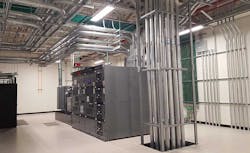Data Center Infrastructure Monitoring Key to Power Quality
The final entry in a special report series highlights the importance of data center infrastructure monitoring to ensuring power quality in today’s colocation facilities.
Get the full report.
Data Center Infrastructure Monitoring
It is impossible to discuss monitoring power quality without mentioning Data Center Infrastructure Monitoring (DCIM), as well as power monitoring and management systems. Traditionally, the facility power and cooling systems are monitored by a Building Management System (BMS). Various DCIM systems have been introduced over the past decade, which offer a more granular insight to the data center whitespace and in some cases interfacing with existing BMS systems. In other cases, they are IT centric. In most cases, the power monitoring of various points in the power chain consists of the basic voltage and current sensors, as well as the derived kVa and kW metered data. PQ monitoring is not normally included. Data from PQ metering can be monitored in some DCIM systems. Large scale data center may install full scale power quality sensors as part of a high-level dedicated power management system. However, these PM/PQ systems are relatively expensive.
In most cases, the power monitoring of various points in the power chain consists of the basic voltage and current sensors, as well as the derived kVa and kW metered data.
Where, Why and What to Monitor
The more points that are monitored the greater the granularity of the data, resulting in better correlation of the cause and faster pinpointing of the source or the type of problem. However, while ideal, it is also the most costly.
From a practical matter and cost effectiveness perspective, even a single PQ meter placed in a critical location can provide a strategic view into the power chain. Since the most critical and sensitive consideration the PQ to the ITE, the 480 volt input from the UPS and 208/120V output of a floor level PDU could be monitored by a single PQM with multichannel inputs. This could be relatively easy to install in the PDU. For sites with redundant UPS, PDUs and power paths obviously would be required.
The UPS will continue to supply the ITE load if there is utility power outage until the load can be transferred to back-up generator(s). However, there are large inrush currents upon transfer to the generator, which can impact power quality and may generate harmonic distortion. The same issue occurs when power is transferred back to utility when it becomes available.
If there are concerns that the utility power is questionable, again, a single unit could be installed at the output of the automatic transfer switch (ATS). This would allow monitoring the PQ of the incoming utility, as well at the PQ of output of the back-up generator.
While the primary purpose of adding a PQM is the detection and logging of PQ issues, it also provides much more useful information and oversight for those sites which may lack a power management system.
When installed in the main distribution panel, a multichannel PQM can monitor the total power to the data center, as well as separately measuring the power consumed by cooling system and the UPS supporting the ITE. This, when combined with temperature and humidity monitoring, would help optimize the cooling system energy efficiency.
There are many more points that could be monitored; the above examples provide a great deal of insight, with a minimum investment. Of course, while the primary purpose of adding a PQM is the detection and logging of PQ issues, it also provides much more useful information and oversight for those sites which may lack a power management system.
This includes measuring: power demand, power factor, phase imbalance, ground currents, etc. This information can then be used to optimize the efficiency and maximize available capacity of the UPS and downstream power distribution.
Power Quality at the Edge
The computing architectures and communication system infrastructure has been undergoing a metamorphosis over the last several years. It began with so called “edge computing” in order to minimize latency and optimize responsiveness to end-user devices. It was accelerated in the anticipation of 5G communications and the expected demand of localized data processing.
While large data centers continue to be built, more and more computing systems are being deployed in remote areas. In many cases, they are collocated with cell sites and are not staffed. These remote sites are subject to multiple, varying and sometime frequent PQ problems and are candidate for a PQM which can send alerts and PQ data to a central monitoring location. It should be noted that in addition to PQ monitoring functions some multichannel PQ meters can also accept data from temperature and humidity sensors, adding to their cost effectiveness. The need for these type PQMs at smaller server rooms, in satellite office locations, also should be considered.
Summary – The Bottom Line
The data center environment is highly dynamic. IT equipment is added or upgraded almost continuously. Even in well managed data centers, IT loads may not be well balanced across the phases, which can cause energy waste, as well as limiting power capacity throughout the power chain.
In addition, there are many elements that were discussed above that have the potential to create PQ issues which can impact IT operation.
This is not to say that every data center has been impacted by these issues. However, experience has driven a significant percentage of recently built data centers have specified PQ monitoring as a standard element of their power management systems. Technology improvements have made standalone, smart PQMs cost-effective. Their small size makes them relatively easy to install into (or adjacent to), existing electrical distribution equipment.
Catch up the first entry, and second entry in the series, as well. And last week, we highlighted perfecting power quality monitoring.
Download the full report, “Understanding the Importance of Power Quality in the Data Center,” to explore the importance of power quality management in the data center.


